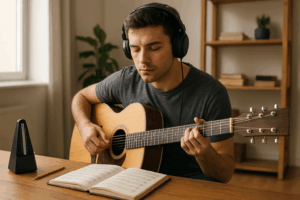Finding your unique musical style is an exciting journey that can help you express yourself authentically and set you apart as a musician. Whether you’re just starting to learn music or you’re an experienced musician, developing a distinctive style takes time, experimentation, and self-reflection. In this article, we’ll explore how you can discover and nurture your own musical style, blending influences from different genres while staying true to your musical identity.
1. Understand the Basics Before Exploring Styles
Before diving into different musical styles, it’s essential to have a solid foundation in the fundamentals of music. Understanding music theory, rhythm, harmony, and melody will help you appreciate various genres and experiment with them effectively.
How to Build a Strong Musical Foundation:
- Learn Music Theory: Understanding basic concepts like scales, chords, and key signatures will give you the tools to play and create music across various genres. The more you know about theory, the more versatile you’ll become as a musician.
- Master Your Instrument: Whether you’re playing guitar, piano, or any other instrument, it’s important to become proficient. The more skilled you are, the easier it will be to experiment with different musical ideas.
- Practice Regularly: Build good habits by practicing frequently and consistently. The more you practice, the better you’ll get at adapting to different musical styles and incorporating them into your own playing.
Having a strong musical foundation will make it easier to branch out into different styles and find your unique voice.
2. Explore Different Genres
One of the most exciting parts of finding your musical style is exploring the vast array of genres and sounds that exist. As a beginner, you may gravitate toward specific genres based on your preferences, but the key is to explore as much as possible.
How to Explore Different Genres:
- Listen to a Variety of Music: Start by listening to music from different genres, including jazz, blues, classical, rock, pop, country, hip-hop, electronic, and more. Pay attention to the elements that appeal to you, such as rhythm, melody, lyrics, or instrumentation.
- Learn Songs from Different Genres: Practice playing songs from different styles. For example, you could learn a classical piece, then try something more modern like a pop or jazz song. This will give you an idea of what techniques are common in each genre and how you can incorporate them into your playing.
- Attend Live Shows or Concerts: If possible, attend live performances of different genres. Seeing musicians perform can provide inspiration and allow you to understand how different styles translate in a live setting.
Exploring various genres will help you find the sounds and techniques that resonate with you, shaping the foundation of your unique musical style.
3. Experiment with Different Techniques and Sounds
Once you’ve explored different genres and gained a solid understanding of music fundamentals, it’s time to experiment. The more you play, the more you’ll develop your own sound. Don’t be afraid to mix techniques, sounds, and rhythms from different styles.
How to Experiment with Music:
- Try Different Techniques: Experiment with techniques from different genres, such as fingerpicking on guitar, classical phrasing on piano, or slap bass in funk. Each technique offers a different way of expressing yourself through music.
- Create Fusion Styles: Don’t be afraid to blend elements from different genres. Many successful musicians have created their own unique style by combining rock with electronic, jazz with classical, or hip-hop with soul.
- Use Effects and Gear: Depending on the instrument you play, experimenting with effects (like reverb, distortion, or delay) can dramatically change your sound. For example, if you’re a guitarist, using pedals can create unique textures and tones that define your style.
The key is to explore and mix various sounds until you find a combination that feels authentic and exciting to you.
4. Identify Your Musical Influences
As you experiment, take note of the musicians and bands that inspire you the most. These influences will play a crucial role in shaping your style. Understanding why you are drawn to certain artists can help you find your own voice within those influences.
How to Identify Your Musical Influences:
- Listen Closely to Your Favorites: Analyze the music of artists you admire. What aspects of their music do you love? Is it their songwriting, their unique use of harmony, or their rhythmic approach? Identifying these aspects can help you incorporate them into your own playing.
- Observe How They Express Emotion: Many artists have a unique way of expressing emotion through music. Pay attention to how these musicians communicate feelings through their music and try to incorporate similar emotional depth into your own compositions.
- Take Notes: Keep a journal of the artists, techniques, and elements that inspire you. Refer back to these notes when you need inspiration or when you’re unsure about your own style.
Your influences will guide you, but remember that your style is ultimately about what feels authentic to you.
5. Stay Authentic to Yourself
While influences and experimentation are important, it’s equally important to stay true to your own personality and musical voice. Your unique musical style should reflect who you are and what you want to communicate through your music.
How to Stay Authentic:
- Trust Your Instincts: Listen to your inner musical voice. If something feels right, continue with it. If it doesn’t, don’t be afraid to change direction. Authenticity comes from following your own path, not imitating others.
- Express Your Emotions: Music is a powerful way to communicate emotions, and your unique style should reflect your personal experiences, feelings, and ideas. Whether you’re playing an upbeat tune or a melancholic ballad, infuse your music with your own emotions and perspectives.
- Don’t Rush the Process: Finding your unique style is a gradual process. It takes time to hone your voice and feel confident in your sound. Be patient and allow your style to develop organically.
By staying authentic to yourself, you will create a style that is uniquely yours and resonates with both you and your audience.
6. Collaborate with Other Musicians
Collaborating with other musicians can help you refine your style and gain new perspectives. Working with others allows you to experiment with different sounds, learn new techniques, and get valuable feedback on your playing.
How to Collaborate Effectively:
- Join a Band or Ensemble: Whether it’s a local band, jam session, or online collaboration, playing with others exposes you to different musical approaches and challenges you to adapt your style.
- Share Ideas: Collaborating with other musicians can open up new creative pathways. Share your ideas, techniques, and influences with others, and be open to feedback and suggestions.
- Learn from Each Other: Every musician has their own unique skills and approach to playing. Working with others gives you the opportunity to learn from their experiences and incorporate new elements into your own playing.
Collaboration helps you expand your musical horizons and refine your style by incorporating diverse influences and techniques.



